Finite Element Analysis of Liquefied Ammonia Tank for Mobility Vehicles Employing Polymers and Composites
Abstract
1. Introduction
2. Methodology
2.1. Pressure Vessel Design
2.1.1. Impact Test (Regulation No. 67 UN/ECE)
2.1.2. Burst Test (Regulation of FMVSS 304)
2.2. Optimization Method
3. Finite Element Method
3.1. Material Model
3.2. Simulation Details
4. Results and Discussion
4.1. Burst Test
4.1.1. Stress Distribution
4.1.2. Laminate Stacking Sequence of [±θ]6s
4.1.3. Laminate Stacking Sequence of [0/±θ]4s
4.1.4. Laminate Stacking Sequence of [90/±θ]4s
4.1.5. Laminate Stacking Sequence of [90/±θ/90]3s
4.1.6. Laminate Stacking Sequence of [0/±θ/90]3s
4.1.7. Comparison between Stacking-Sequences
4.2. Impact Test
4.2.1. Effect of Stacking Sequence on the Liner
4.2.2. Energy Dissipation
4.2.3. Failure Mode Composite
5. Conclusions
Author Contributions
Funding
Acknowledgments
Conflicts of Interest
References
- IPCC. Proposed Outline of the Special Report in 2018 on the Impacts of Global Warming of 1.5 °C Above Pre-Industrial Levels and Related Global Greenhouse Gas Emission Pathways, in the Context of Strengthening the Global Response to the Threat of Climate Cha; IPCC: Geneva, Switzerland, 2018; Volume 2. [Google Scholar]
- Allen, M.R.; Dube, O.P.; Solecki, W.; Aragón-Durand, F.; Cramer, W.; Humphreys, S.; Kainuma, M.; Kala, J.; Mahowald, N.; Mulugetta, Y.; et al. IPCC: Framing and Context; IPCC: Geneva, Switzerland, 2018. [Google Scholar]
- IPCC. Summary for Policymakers. In Climate Change 2014, Mitigation of Climate Change. Contribution of Working Group III to the Fifth Assessment Report of the Intergovernmental Panel on Climate Change; Edenhofer, O.R., Pichs-Madruga, Y., Sokona, E., Farahani, S., Kadner, K., Seyboth, A., Adler, I., Baum, S., Brunner, P., Eickemeier, B., et al., Eds.; Cambridge University Press: Cambridge, UK, 2014; ISBN 9781107661820. [Google Scholar]
- Dutta, S. A review on production, storage of hydrogen and its utilization as an energy resource. J. Ind. Eng. Chem. 2014, 20, 1148–1156. [Google Scholar] [CrossRef]
- Møller, K.T.; Jensen, T.R.; Akiba, E.; Li, H. wen Hydrogen—A sustainable energy carrier. Prog. Nat. Sci. Mater. Int. 2017, 27, 34–40. [Google Scholar] [CrossRef]
- Aziz, M.; Putranto, A.; Biddinika, M.K.; Wijayanta, A.T. Energy-saving combination of N2 production, NH3 synthesis, and power generation. Int. J. Hydrogen Energy 2017, 42, 27174–27183. [Google Scholar] [CrossRef]
- Roszak, R.; Firlej, L.; Roszak, S.; Pfeifer, P.; Kuchta, B. Hydrogen storage by adsorption in porous materials: Is it possible? Colloids Surfaces A Physicochem. Eng. Asp. 2016, 496, 69–76. [Google Scholar] [CrossRef]
- Andersson, J.; Grönkvist, S. Large-scale storage of hydrogen. Int. J. Hydrogen Energy 2019, 44, 11901–11919. [Google Scholar] [CrossRef]
- Wijayanta, A.T.; Aziz, M. Ammonia production from algae via integrated hydrothermal gasification, chemical looping, N2 production, and NH3 synthesis. Energy 2019, 174, 331–338. [Google Scholar] [CrossRef]
- Asia Biomass Office Using Hydrogen Compounds as Renewable Energy Carriers. Available online: https://www.asiabiomass.jp/english/topics/1512_05.html (accessed on 9 March 2018).
- Wijayanta, A.T.; Oda, T.; Purnomo, C.W.; Kashiwagi, T.; Aziz, M. Liquid hydrogen, methylcyclohexane, and ammonia as potential hydrogen storage: Comparison review. Int. J. Hydrogen Energy 2019, 44, 15026–15044. [Google Scholar] [CrossRef]
- Garagounis, I.; Kyriakou, V.; Anagnostou, C.; Bourganis, V.; Papachristou, I.; Stoukides, M. Solid electrolytes: Applications in heterogeneous catalysis and chemical cogeneration. Ind. Eng. Chem. Res. 2011, 50, 431–472. [Google Scholar] [CrossRef]
- Cui, B.; Yu, Z.; Liu, S.; Zhang, J.; Liu, X.; Liu, C.; Zhang, Z. Highly selective and efficient ammonia synthesis from N2 and H2O via an iron-based electrolytic-chemical cycle. Int. J. Hydrogen Energy 2020, 45, 94–102. [Google Scholar] [CrossRef]
- Dincer, I.; Zamfirescu, C. A review of novel energy options for clean rail applications. J. Nat. Gas Sci. Eng. 2016, 28, 461–478. [Google Scholar] [CrossRef]
- Dimitriou, P.; Javaid, R. A review of ammonia as a compression ignition engine fuel. Int. J. Hydrogen Energy 2020, 45, 7098–7118. [Google Scholar] [CrossRef]
- Ezzat, M.; Dincer, I. Exergoeconomic analysis and optimization of a new hybrid fuel cell vehicle. Int. J. Hydrogen Energy 2020, 45, 5734–5744. [Google Scholar] [CrossRef]
- Chu, Y.; Wu, Y.; Chen, J.; Zheng, S.; Wang, Z. Design of energy and materials for ammonia-based extended-range electric vehicles. Energy Procedia 2019, 158, 3064–3069. [Google Scholar] [CrossRef]
- Zamfirescu, C.; Dincer, I. Ammonia as a green fuel and hydrogen source for vehicular applications. Fuel Process. Technol. 2009, 90, 729–737. [Google Scholar] [CrossRef]
- Kishimoto, M.; Muroyama, H.; Suzuki, S.; Saito, M.; Koide, T.; Takahashi, Y.; Horiuchi, T.; Yamasaki, H.; Matsumoto, S.; Kubo, H.; et al. Development of 1 kW-class Ammonia-fueled Solid Oxide Fuel Cell Stack. Fuel Cells 2020, 20, 1–9. [Google Scholar] [CrossRef]
- Zhao, Y.; Setzler, B.P.; Wang, J.; Nash, J.; Wang, T.; Xu, B.; Yan, Y. An Efficient Direct Ammonia Fuel Cell for Affordable Carbon-Neutral Transportation. Joule 2019, 3, 2472–2484. [Google Scholar] [CrossRef]
- Kobayashi, H.; Hayakawa, A.; Somarathne, K.D.K.A.; Okafor, E.C. Science and technology of ammonia combustion. Proc. Combust. Inst. 2019, 37, 109–133. [Google Scholar] [CrossRef]
- Duijm, N.J.; Markert, F.; Paulsen, J.L. Safety Assessment of Ammonia as a Transport Fuel; Risø National Laboratory: Roskilde, Denmark, 2005; ISBN 8755034152. [Google Scholar]
- World LPG Association. AUTOGAS Vehicles Catalogue 2018; World LPG Association: Neuilly-sur-Seine, France, 2018. [Google Scholar]
- Shiozawa, F. Energy Carriers that Open Up a Hydrogen Society. Available online: http://ieei.or.jp/2015/05/expl150501/ (accessed on 7 July 2020).
- Propane Education & Research Council. Cylinder Requalification; Propane Education & Research Council: Washington, DC, USA, 2019. [Google Scholar]
- Kamal, A.M.; El-Sayed, T.A.; El-Butch, A.M.A.; Farghaly, S.H. Analytical and finite element modeling of pressure vessels for seawater reverse osmosis desalination plants. Desalination 2016, 397, 126–139. [Google Scholar] [CrossRef]
- Wong, J. CNG and Hydrogen Tank Safety, R&D, and Testing; Powertech Labs Inc.: Surrey, BC, Canada, 2009. [Google Scholar]
- Aziz, M.; Wijayanta, A.T.; Nandiyanto, A.B.D. Ammonia as Effective Hydrogen Storage: A Review on Production, Storage and Utilization. Energies 2020, 13, 3062. [Google Scholar] [CrossRef]
- Samsun, R.C.; Antoni, L.; Rex, M. Advanced Fuel Cells Technology Collaboration Programme Report on Mobile Fuel Cell Application: Tracking Market Trends; IEA Technoogy Collaboration Programme: Paris, France, 2020. [Google Scholar]
- PDH Center. ASME Section I & Section VIII: Fundamentals. PDHonline Course M398; PDH Center: Fairfax, VA, USA, 2012. [Google Scholar]
- Lawate, S.; Deshmukh, B.B. Analysis of Heads of Pressure Vessel. Int. J. Innov. Res. Sci. Eng. Technol. 2015, 4, 759–765. [Google Scholar]
- Zhang, Q.; Xu, H.; Jia, X.; Zu, L.; Cheng, S.; Wang, H. Design of a 70 MPa type IV hydrogen storage vessel using accurate modeling techniques for dome thickness prediction. Compos. Struct. 2020, 236, 111915. [Google Scholar] [CrossRef]
- Hua, T.Q.; Ahluwalia, R.K.; Peng, J.-K.; Kromer, M.; Lasher, S.; McKenney, K.; Law, K.; Sinha, J. Technical assessment of compressed hydrogen storage tank systems for automotive applications. Int. J. Hydrogen Energy 2011, 36, 3037–3049. [Google Scholar] [CrossRef]
- Essentra plc Caps and Plugs: How do HDPE and PP Compare? Available online: https://www.essentracomponents.com/en-us/news/product-resources/caps-and-plugs-how-do-hdpe-and-pp-compare (accessed on 20 June 2020).
- The Plastic Bottles Company Properties of HDPE, LDPE and PET Bottles. Available online: https://blog.theplasticbottlescompany.com/general/articles/properties-hdpe-ldpe-pet-bottles/ (accessed on 20 June 2020).
- Pulungan, D.; Yudhanto, A.; Goutham, S.; Lubineau, G.; Yaldiz, R.; Schijve, W. Characterizing and modeling the pressure- and rate-dependent elastic-plastic-damage behavior of polypropylene-based polymers. Polym. Test. 2018, 68, 433–445. [Google Scholar] [CrossRef]
- Gupta, S.; Sharma, K.; Saxena, N.S. Temperature Dependent Mechanical Analysis of Chalcogenide (CdS, ZnS) Coated PET Films. ISRN Polym. Sci. 2013, 2013, 1–7. [Google Scholar] [CrossRef]
- Tie, Y.; Zhang, Q.; Hou, Y.; Li, C. Impact damage assessment in orthotropic CFRP laminates using nonlinear Lamb wave: Experimental and numerical investigations. Compos. Struct. 2020, 236, 111869. [Google Scholar] [CrossRef]
- Wu, Q.; Zhi, X.; Li, Q.; Guo, M. Experimental and numerical studies of GFRP-reinforced steel tube under low-velocity transverse impact. Int. J. Impact Eng. 2019, 127, 135–153. [Google Scholar] [CrossRef]
- De Camargo, E.J.; Moreschi, E.; Baseggio, W.; Cury, J.A.; Pascotto, R.C. Composite depth of cure using four polymerization techniques. J. Appl. Oral Sci. 2009, 17, 446–450. [Google Scholar] [CrossRef]
- Wang, D.; Liao, B.; Zheng, J.; Huang, G.; Hua, Z.; Gu, C.; Xu, P. Development of regulations, codes and standards on composite tanks for on-board gaseous hydrogen storage. Int. J. Hydrogen Energy 2019, 44, 22643–22653. [Google Scholar] [CrossRef]
- United Nations Economic Commission for Europe. Requirements for the Installation of Specific Equipment for the Use of Liquefied Petroleum Gases in the Propulsion System of a Vehicle; United Nations Economic Commission for Europe: Geneva, Switzerland, 2012. [Google Scholar]
- National Highway Traffic Safety Administration (NHTSA) Section 571.304 of the Federal Motor Vehicle Safety Standards: Compressed Natural Gas Fuel Container Integrity. Available online: https://www.ecfr.gov/cgi-bin/text-idx?SID=7d443eb75ceba033fed91e90f816b574&node=se49.6.571_1304&rgn=div8 (accessed on 20 June 2020).
- Dassault Systèmes Simulia. Abaqus CAE User’s Manual (6.12); Dassault Systèmes Simulia: Providence, RI, USA, 2012. [Google Scholar]
- Gentilleau, B.; Touchard, F.; Grandidier, J.C. Numerical study of influence of temperature and matrix cracking on type IV hydrogen high pressure storage vessel behavior. Compos. Struct. 2014, 111, 98–110. [Google Scholar] [CrossRef]
- Zu, L.; Xu, H.; Jia, X.; Zhang, Q.; Wang, H.; Zhang, B. Winding path design based on mandrel profile updates of composite pressure vessels. Compos. Struct. 2020. [Google Scholar] [CrossRef]
- Ariyama, T.; Mori, Y.; Kaneko, K. Tensile Properties and Stress Relaxation of Polypropylene at Elevated Temperatures. Polym. Eng. Sci. 1997, 37, 81–90. [Google Scholar] [CrossRef]

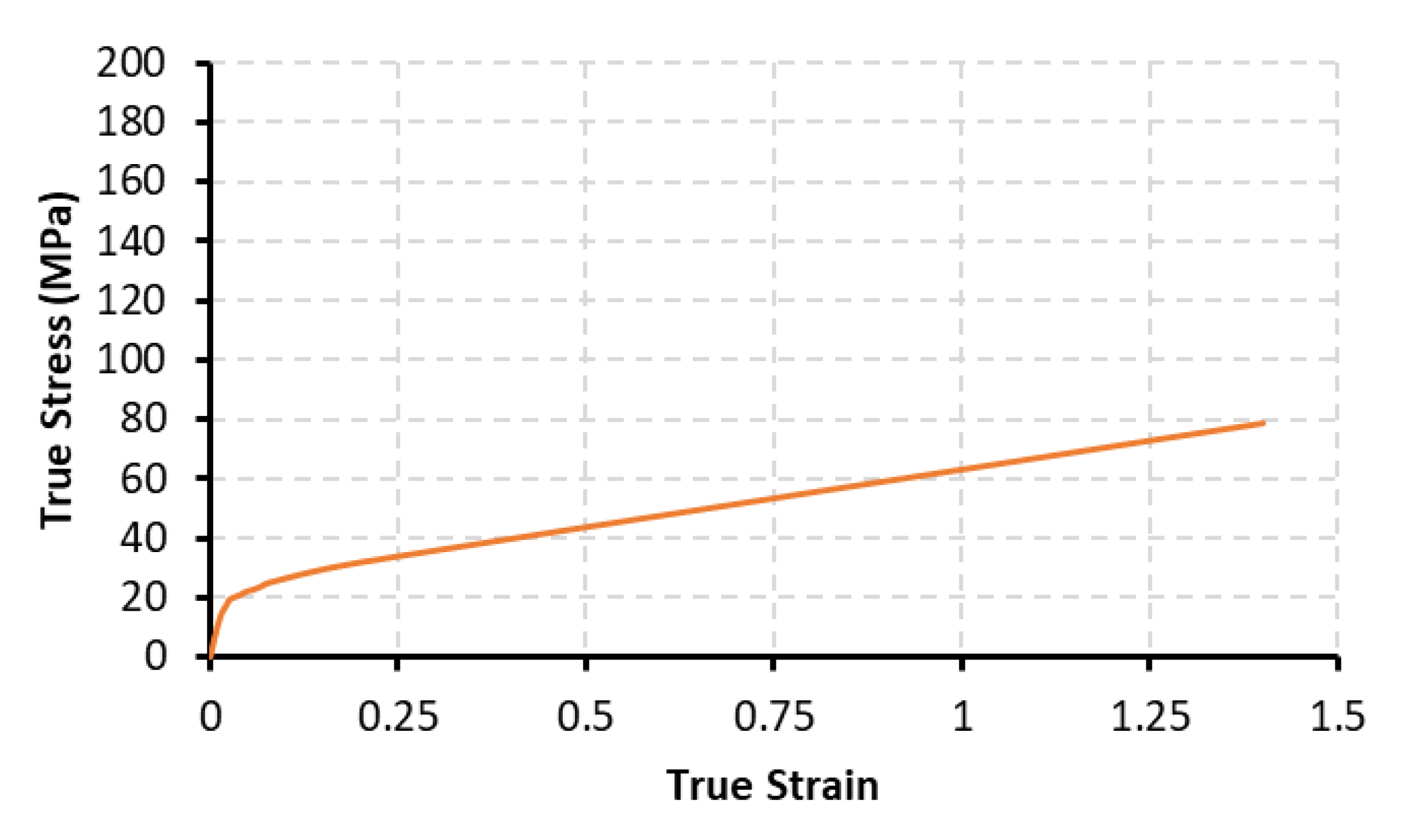
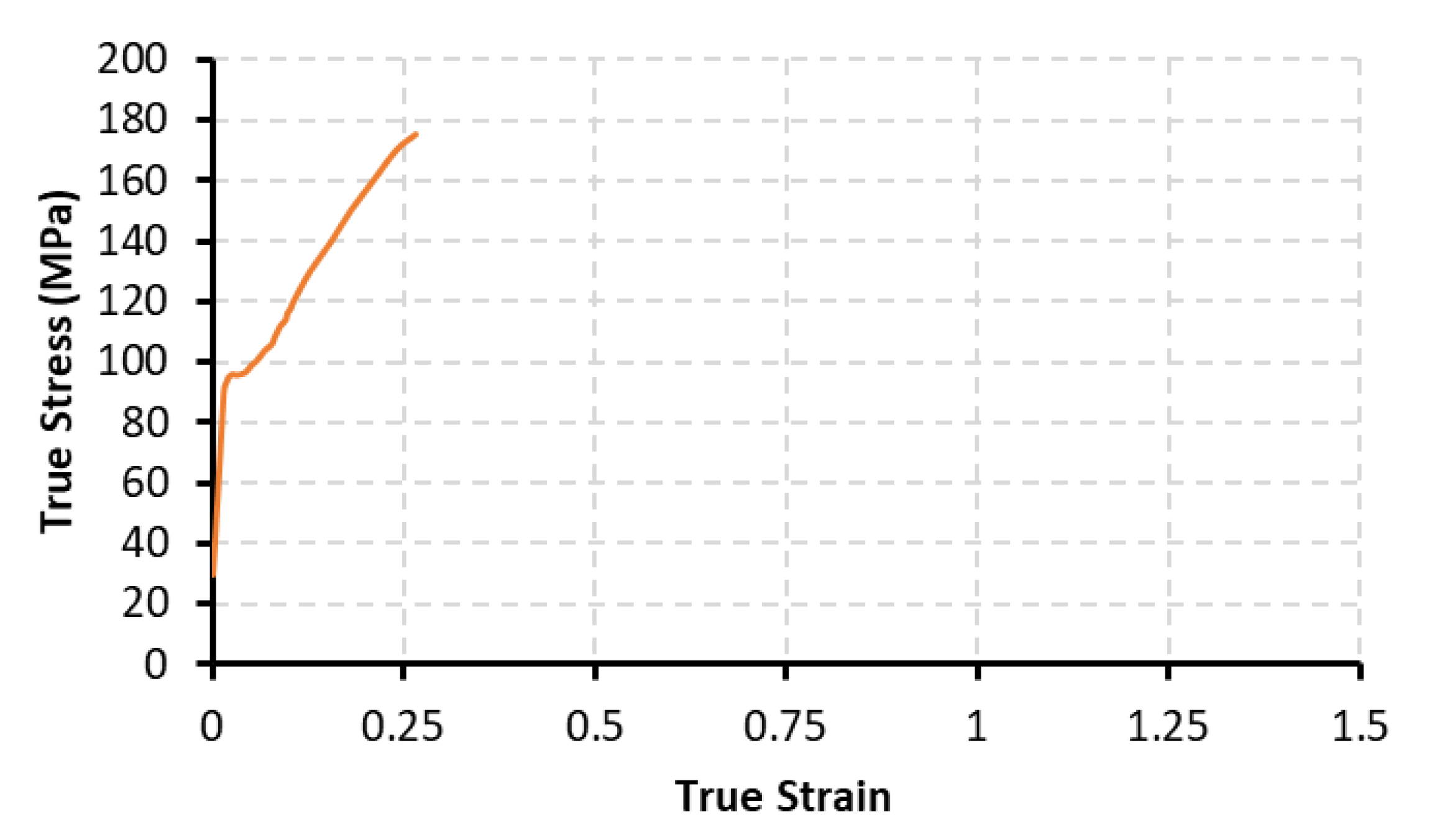
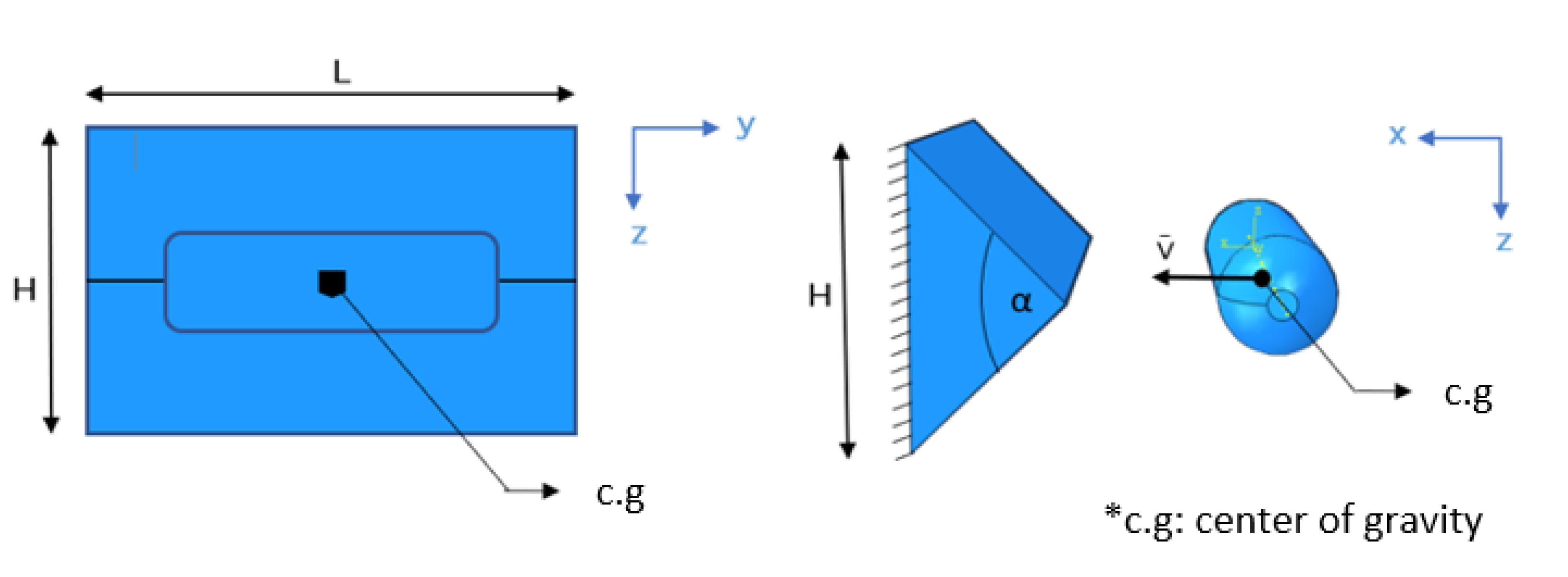
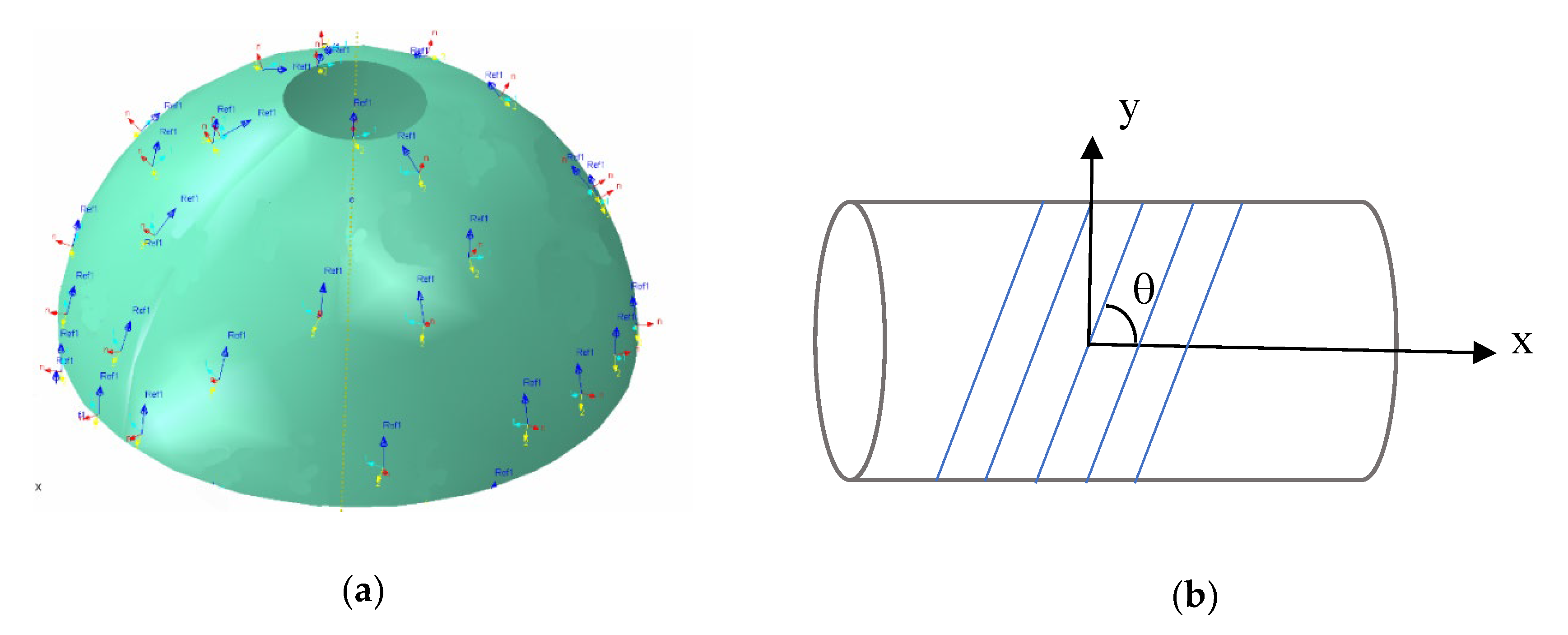
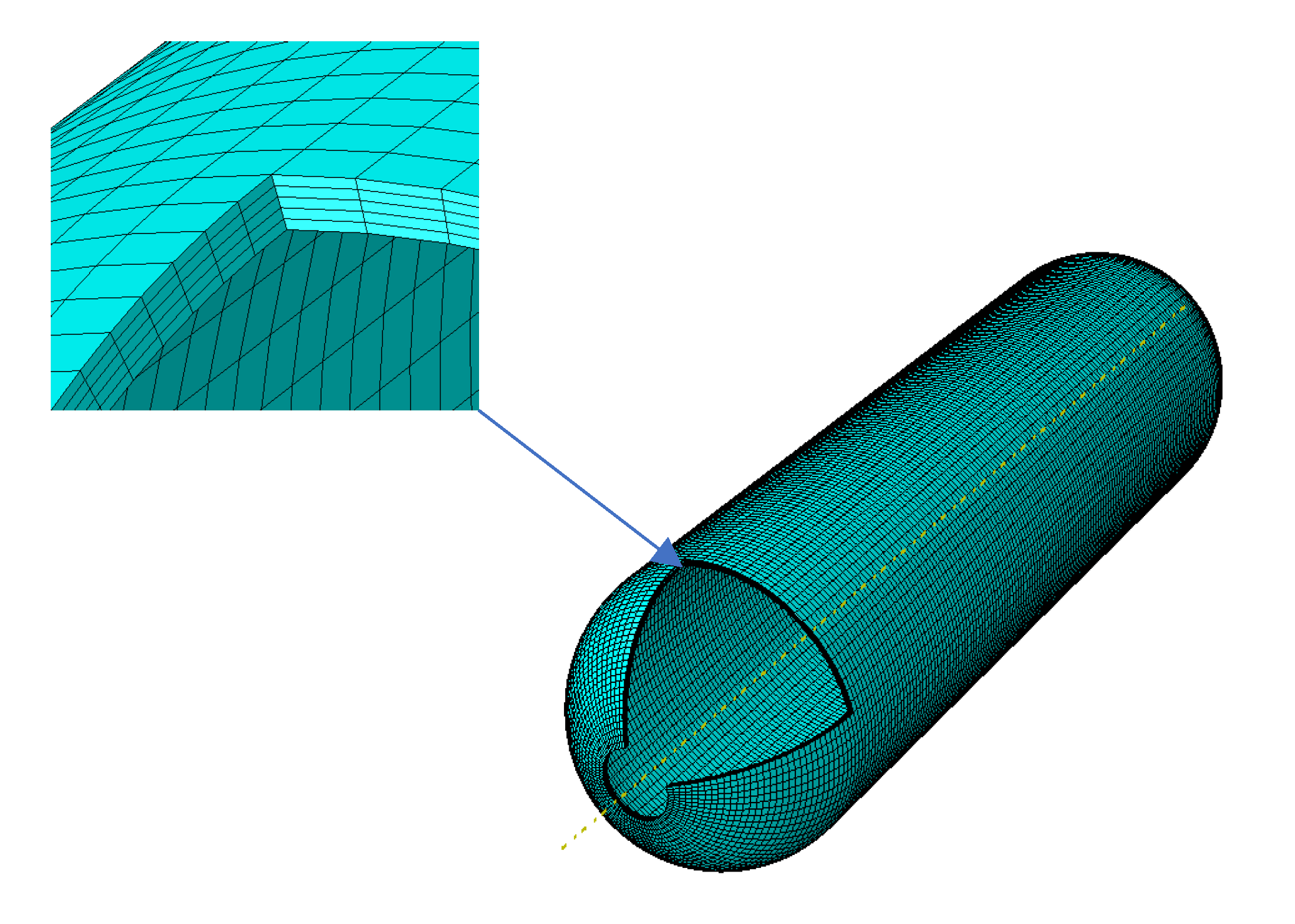
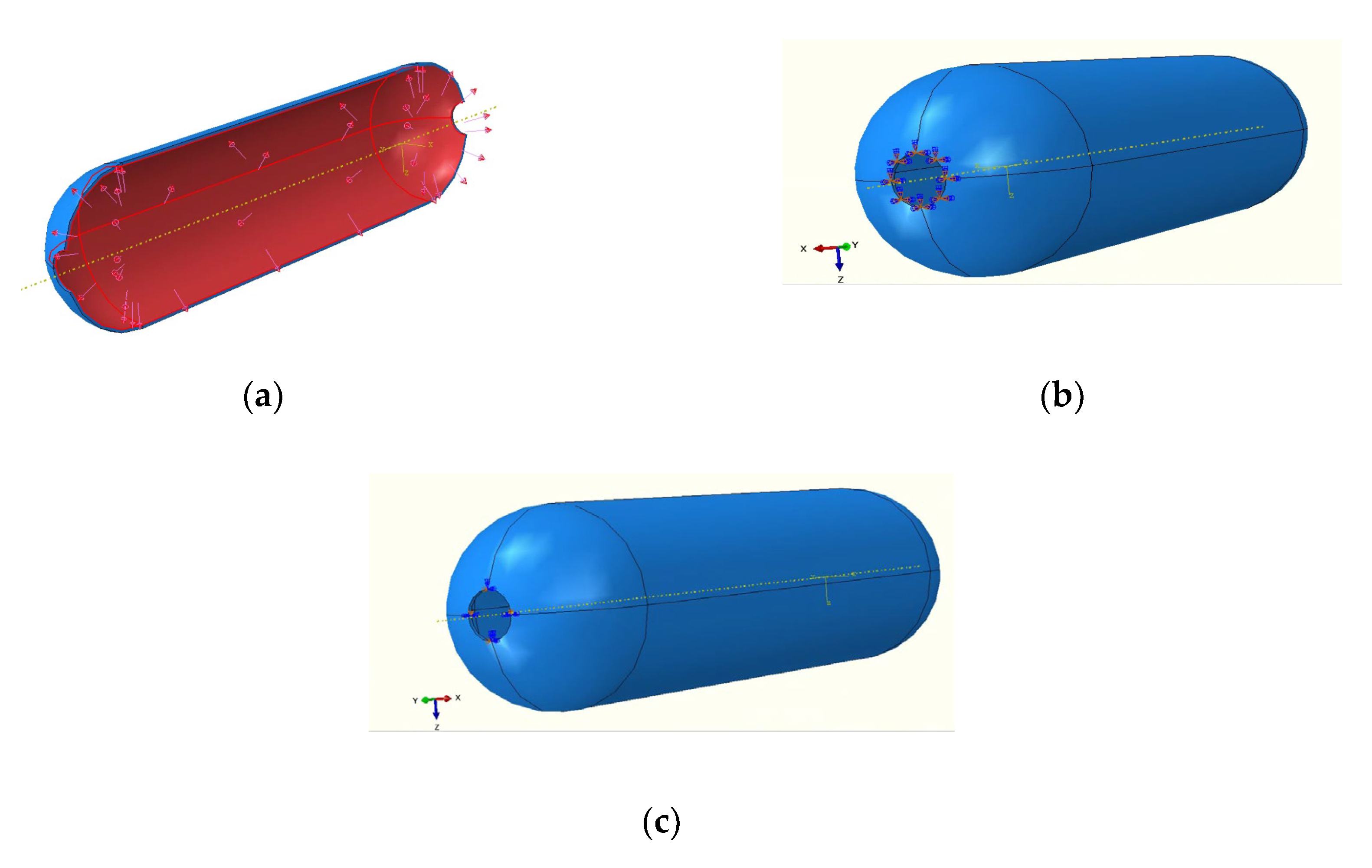
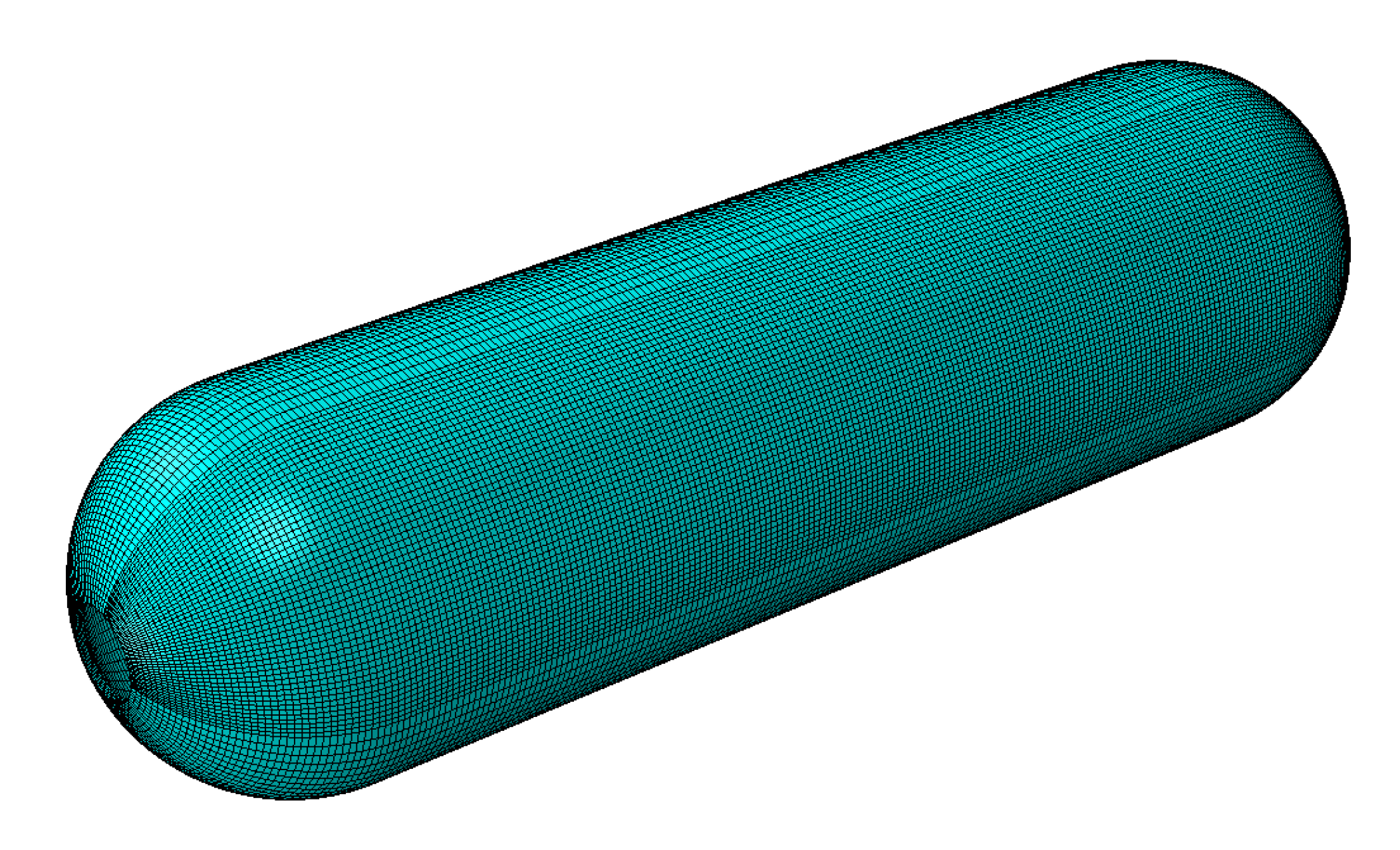
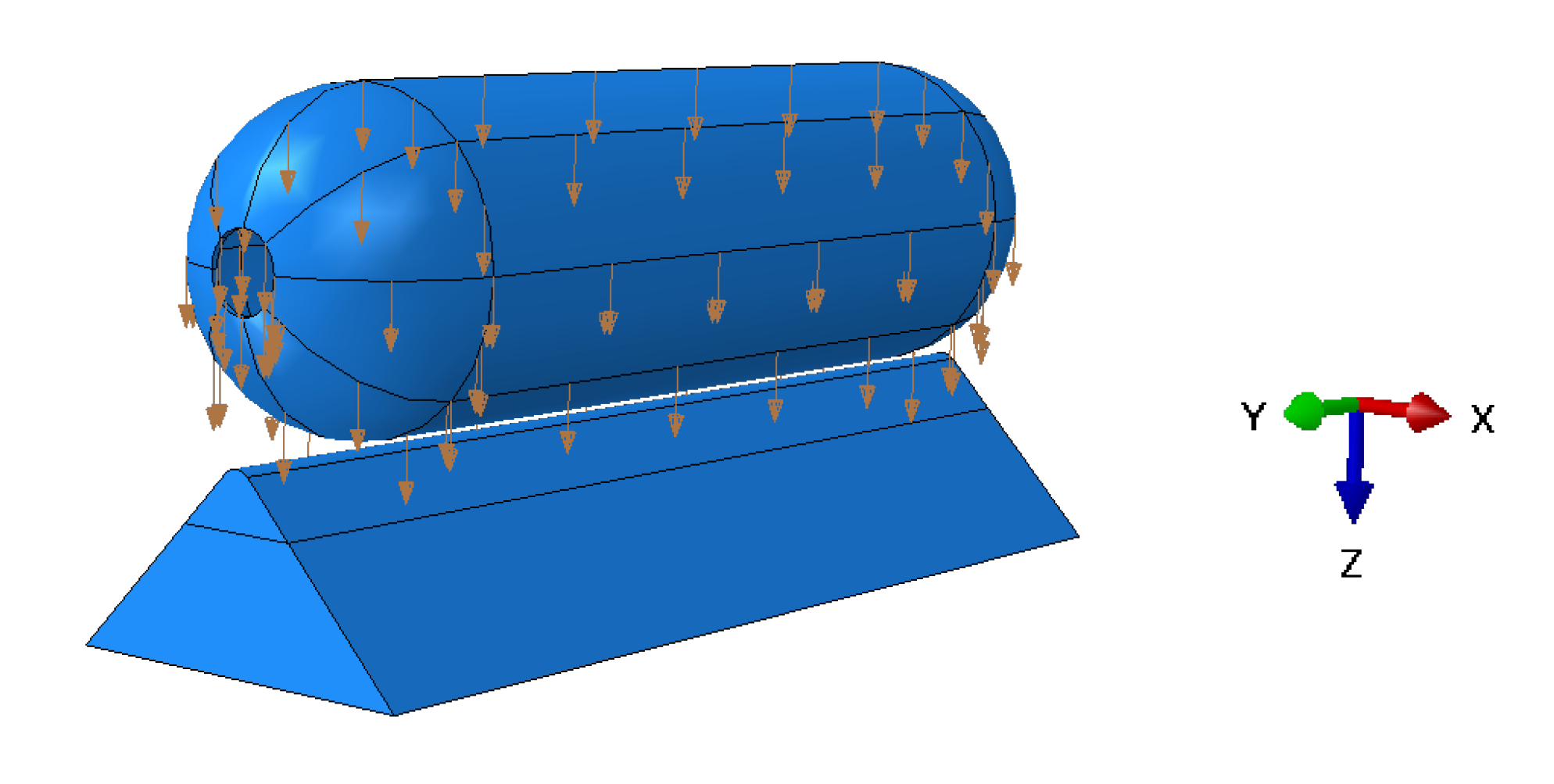
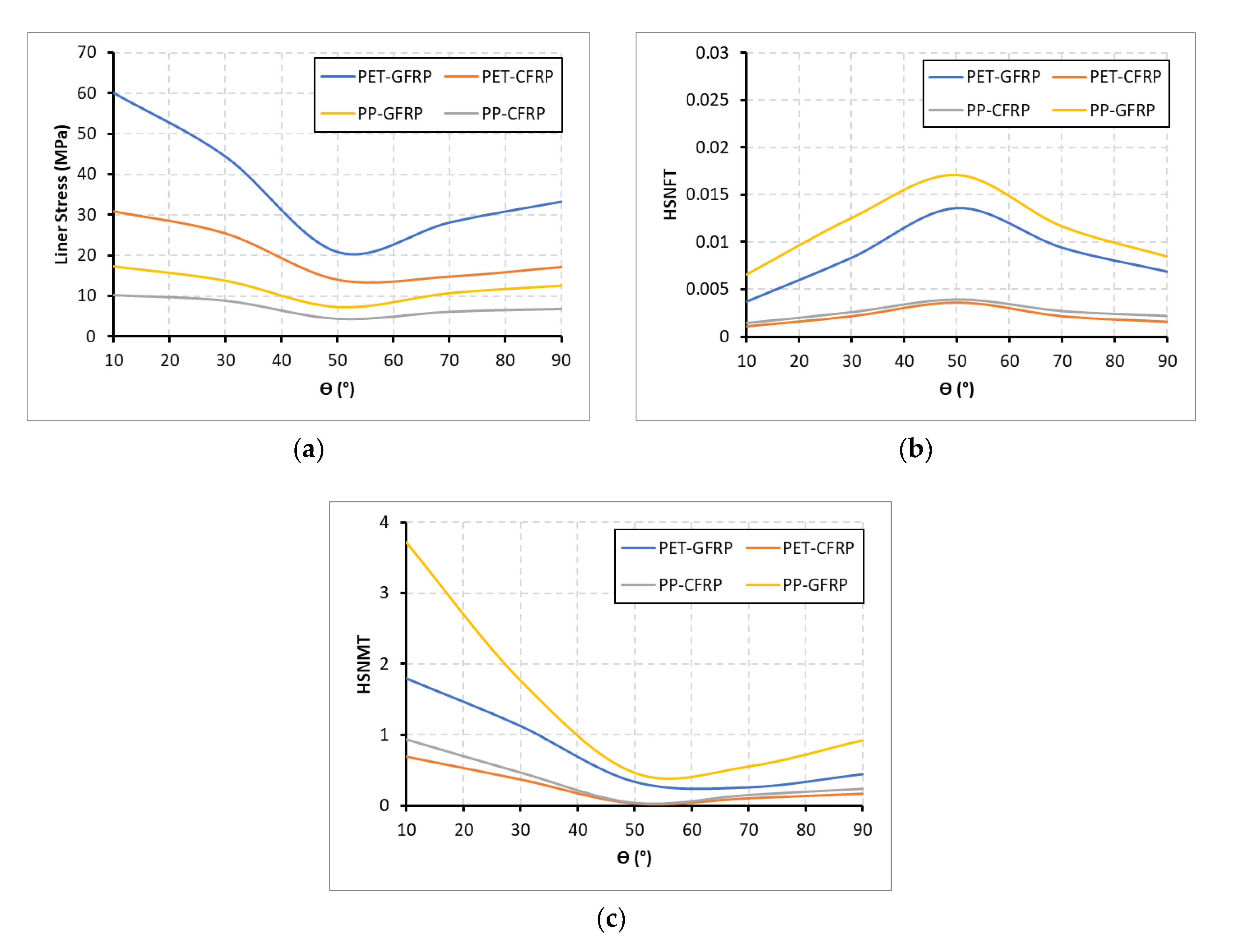
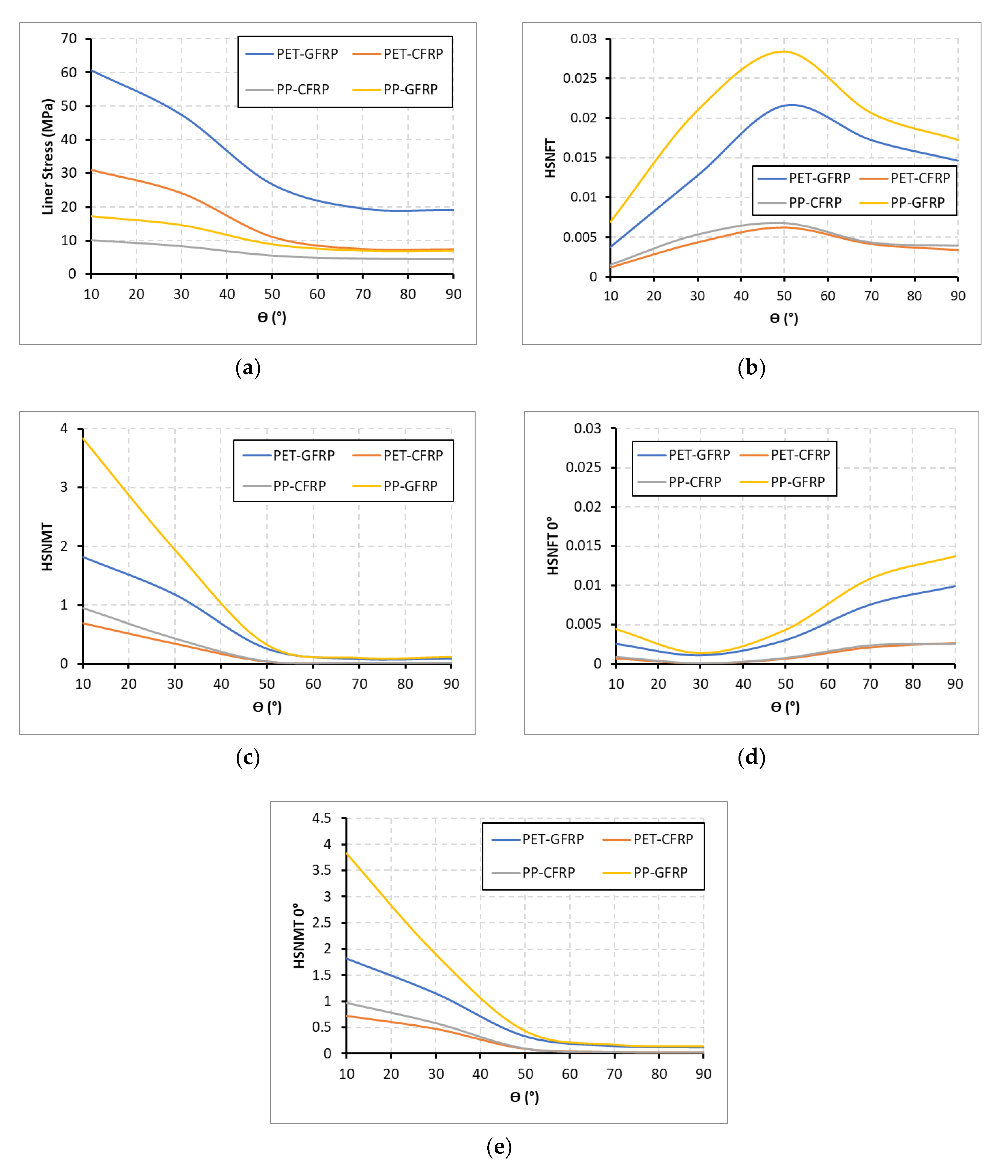

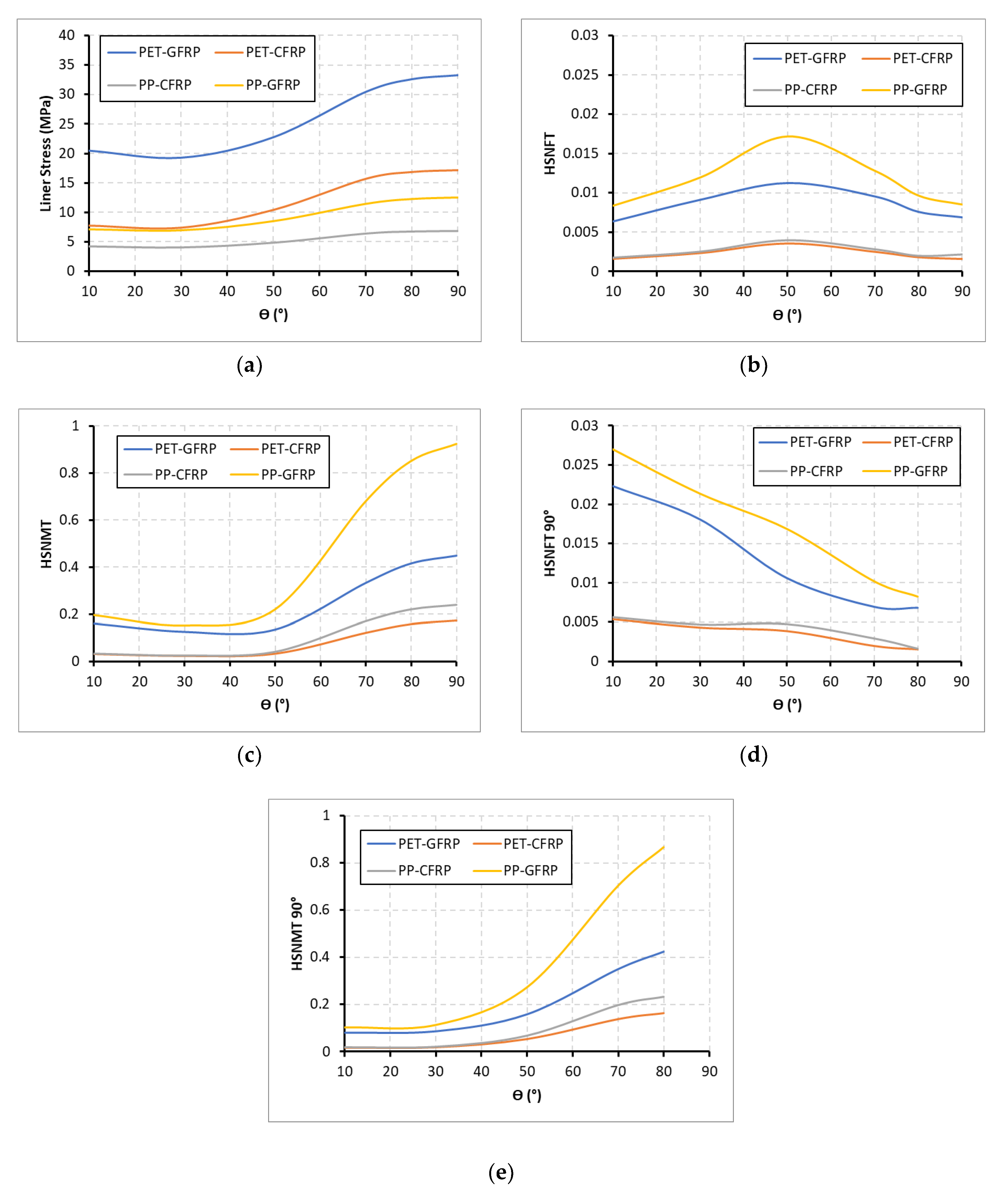
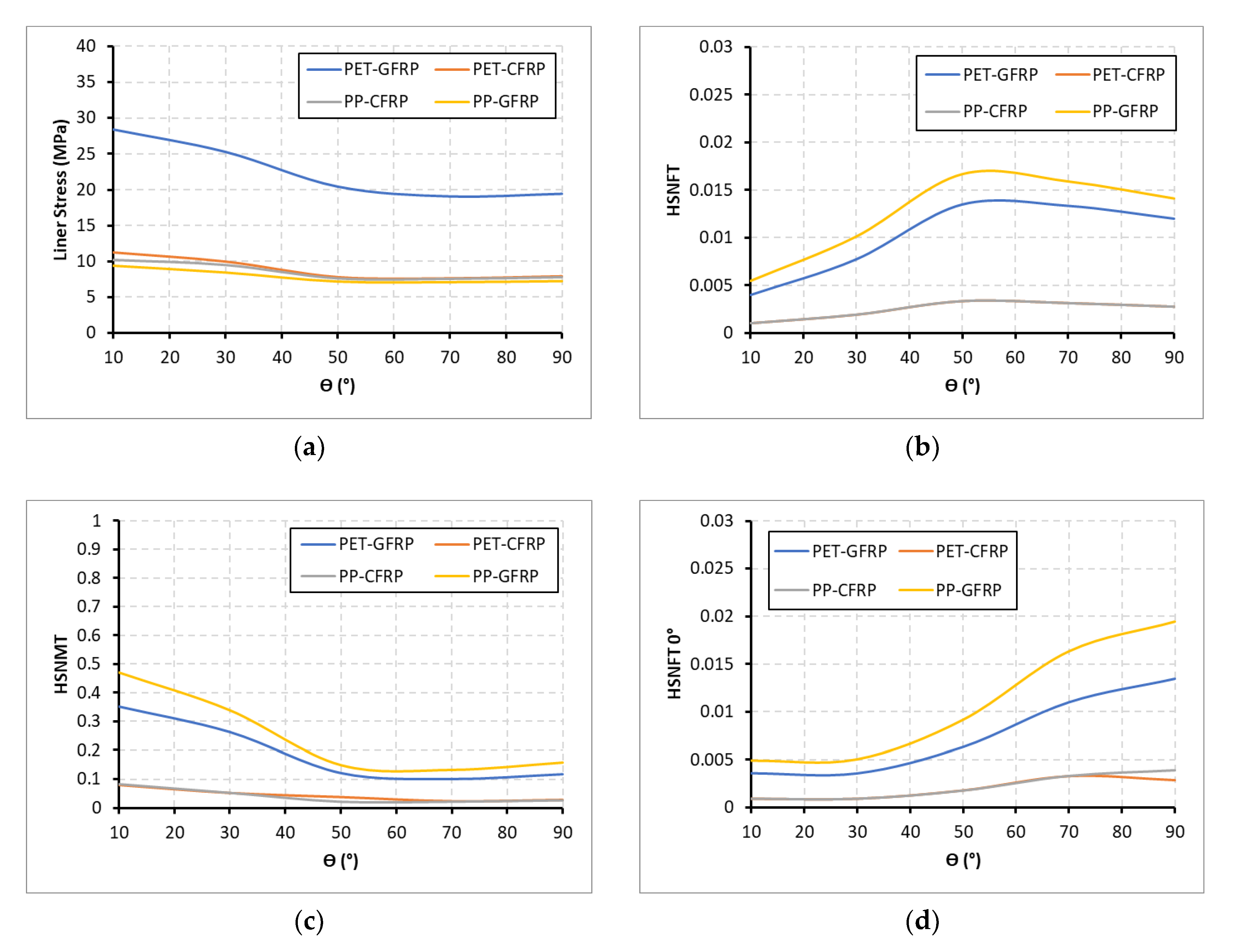
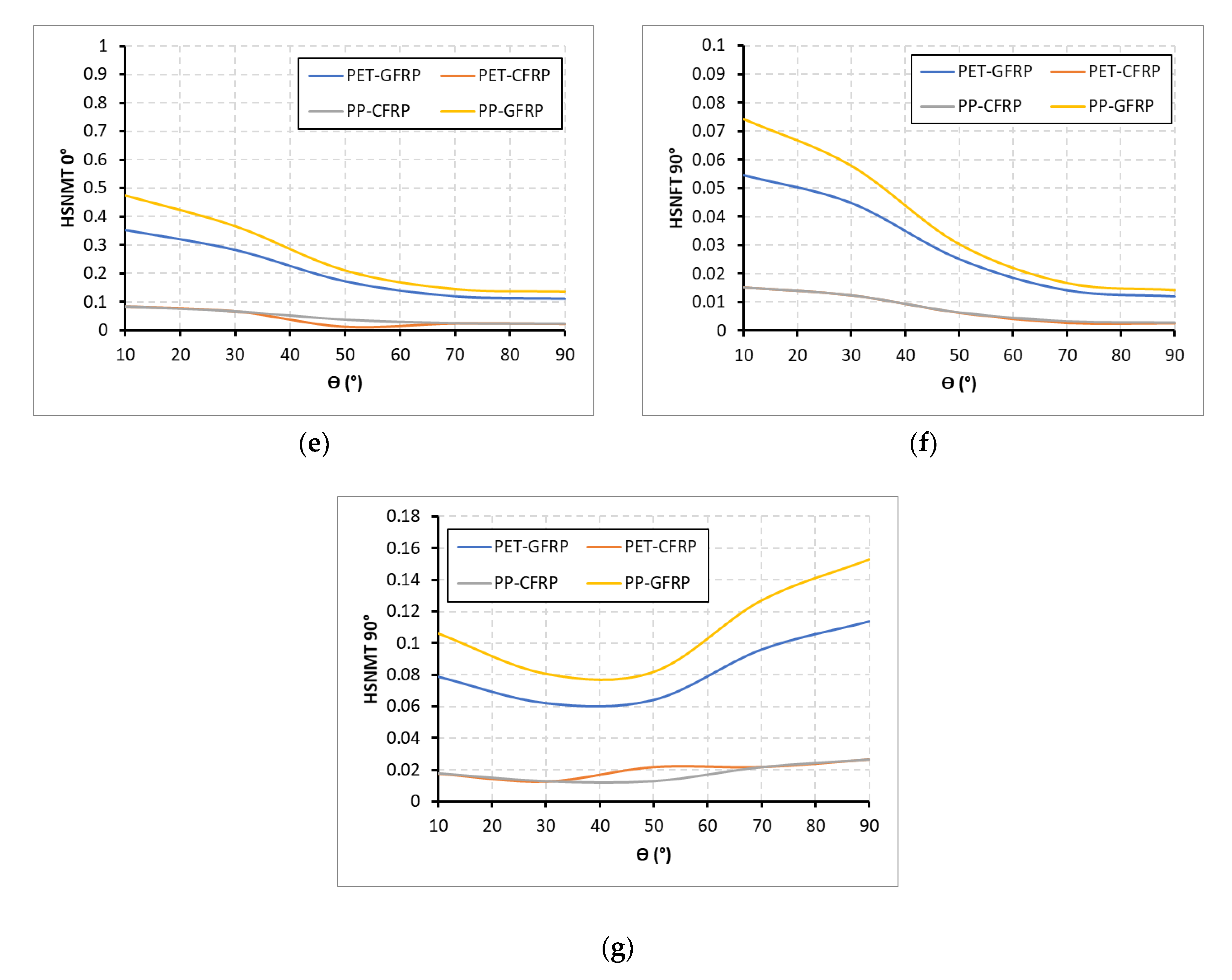

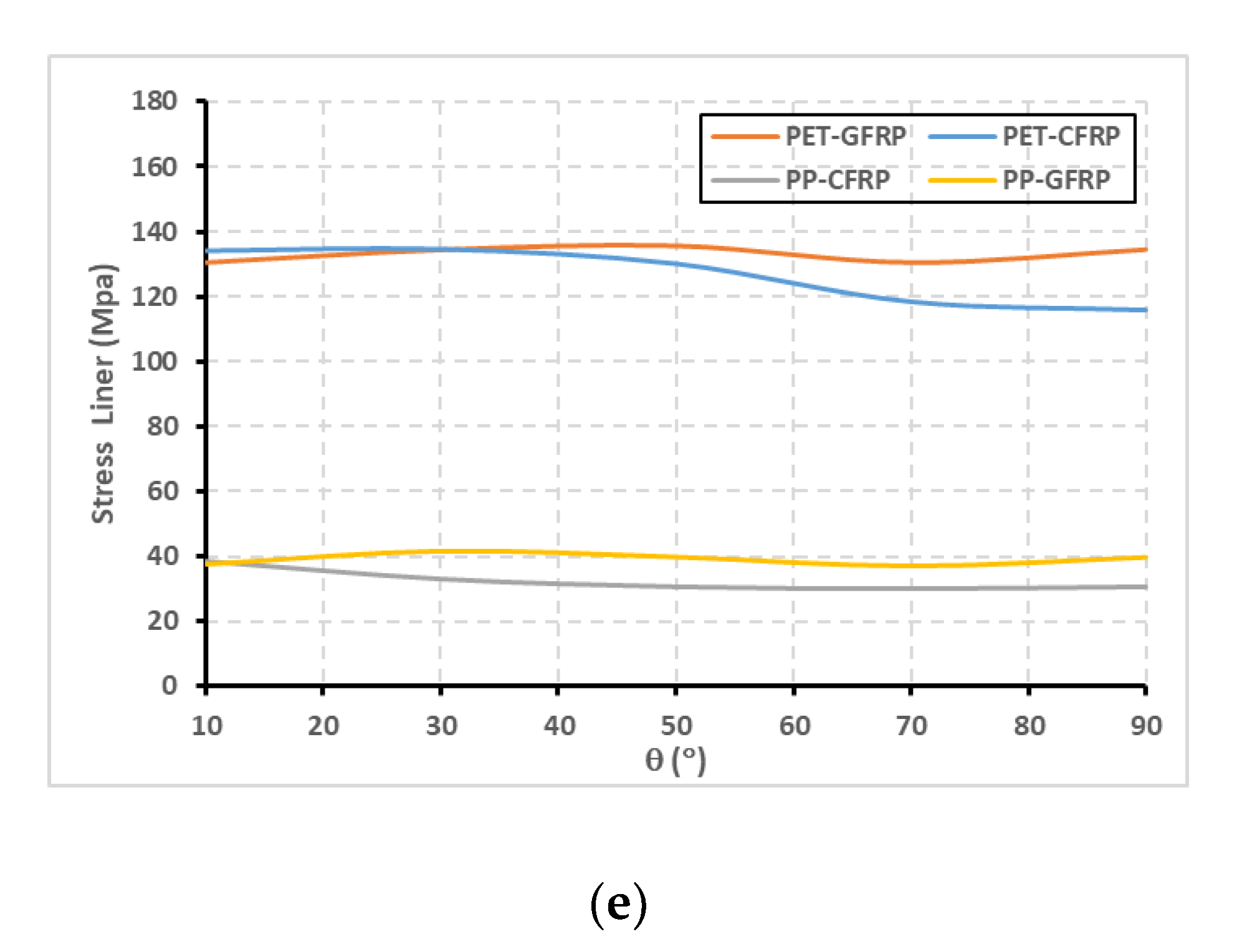


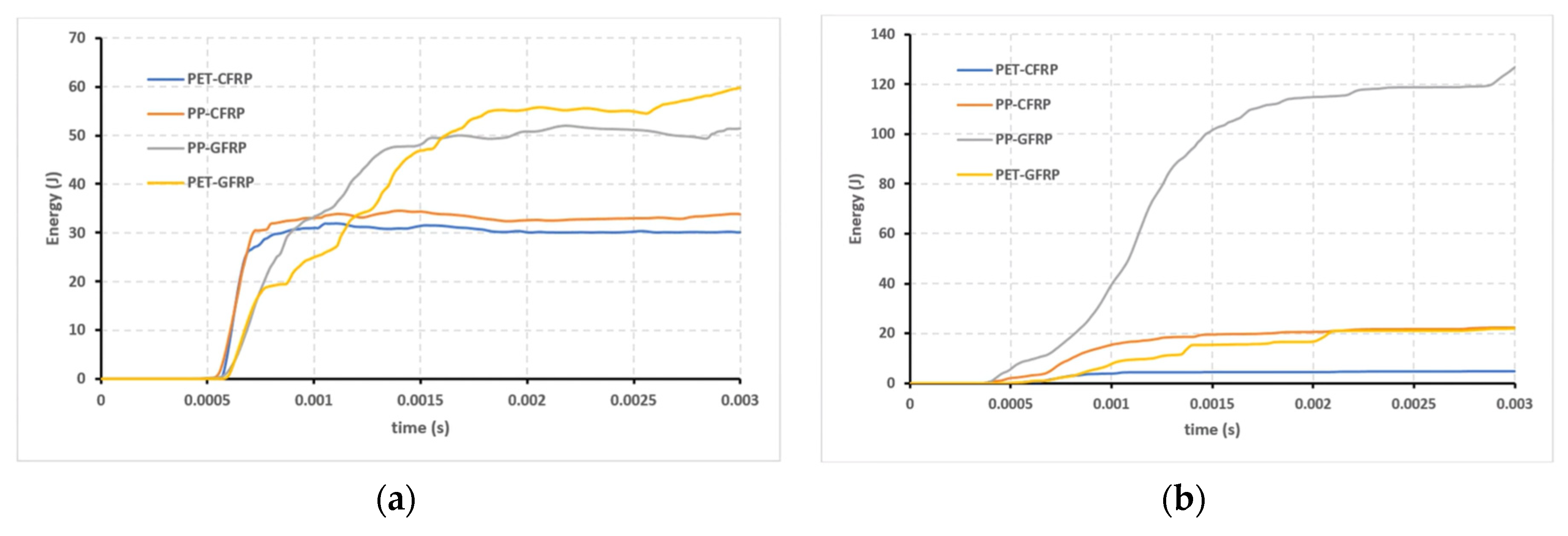

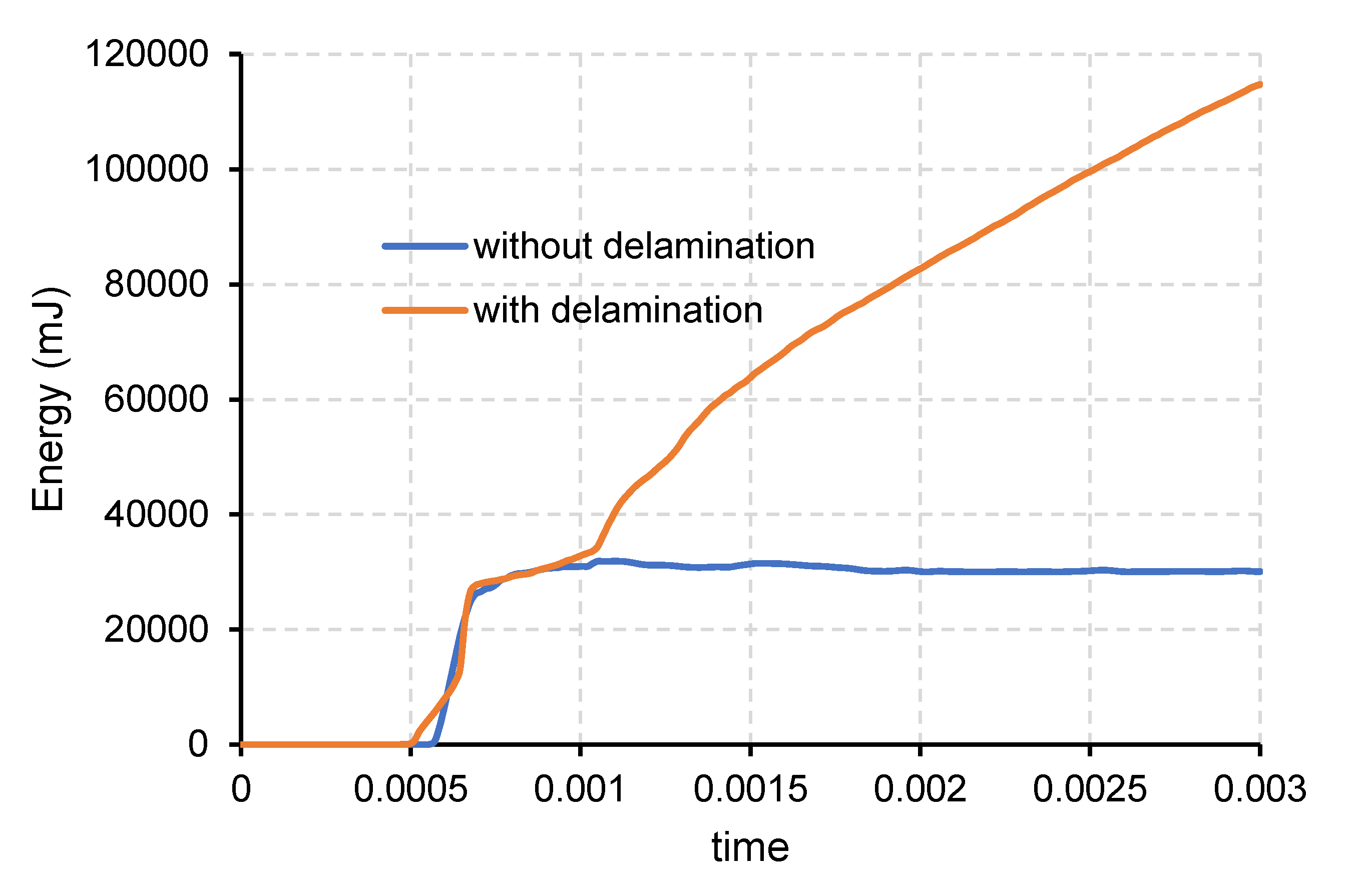
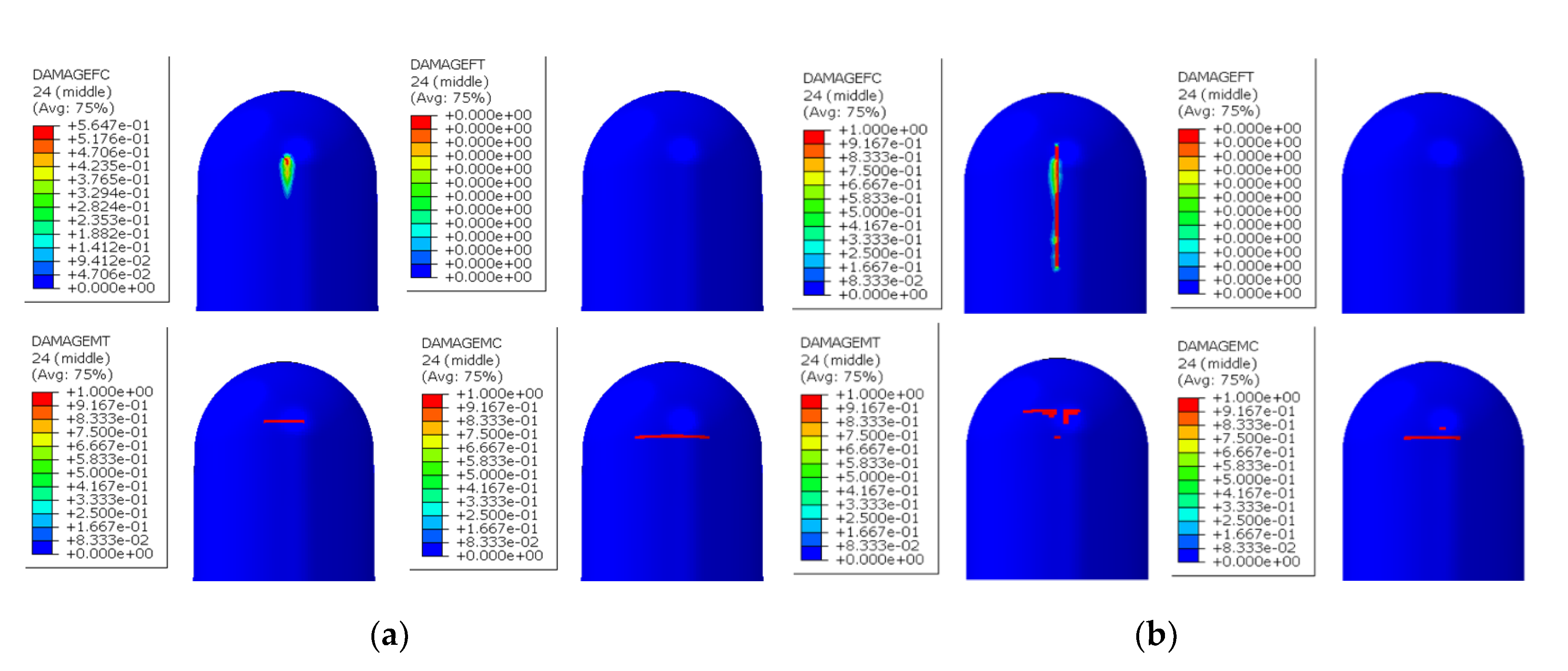
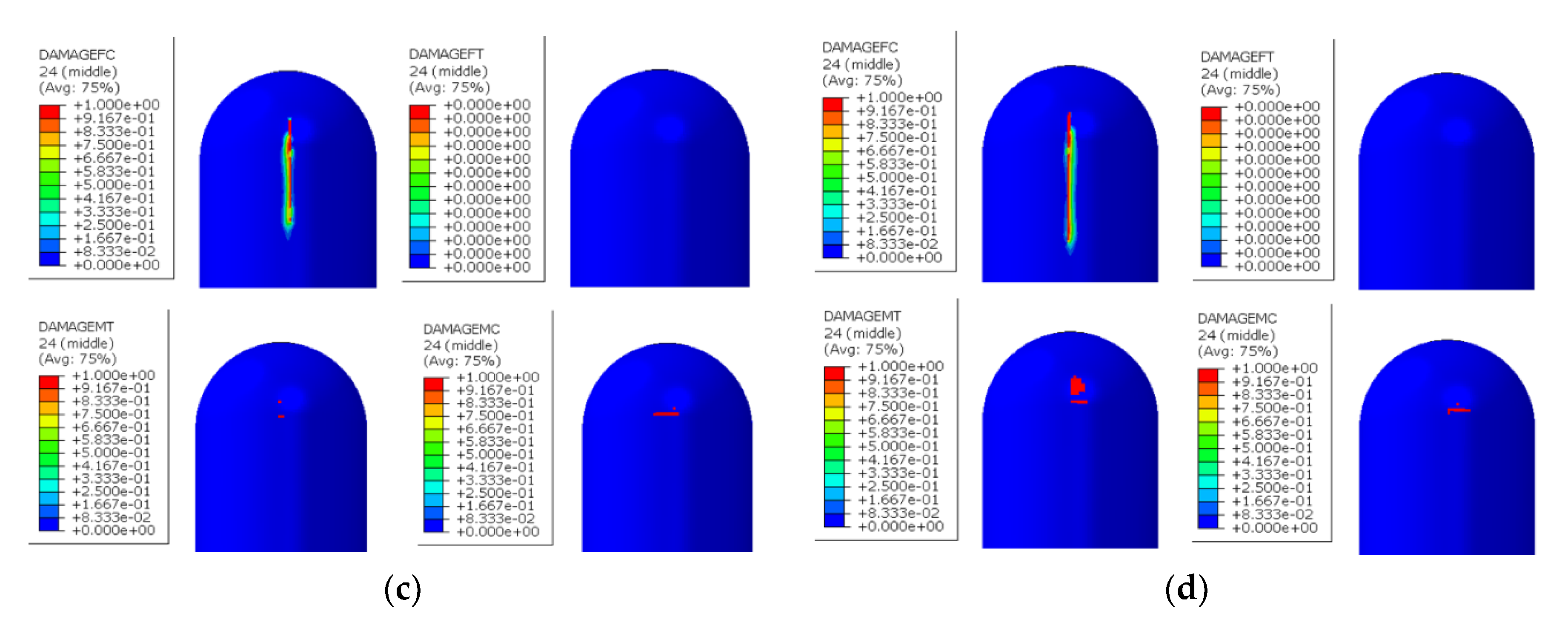
| Properties | Units | Values |
|---|---|---|
| Density at STP | kg/m3 | 0.769 |
| Melting point | °C | −77.73 |
| Boiling point at 1 atm | °C | −33.4 |
| Vapor pressure at 20 °C | kPa | 857.1 |
| Auto ignition temperature | °C | 651 |
| Heat of combustion | MJ/L | 11.2 |
| Thermal conductivity | mW/m·K | 22.19 |
| Critical temperature | °C | 132.4 |
| Critical pressure | MPa | 11.28 |
| Critical density | kg/m3 | 240 |
| Liquid Density at 70 °C | kg/m3 | 551 |
| Liquid Pressure at 70 °C | MPa | 2.8 |
| Properties | Units | PET | PP |
|---|---|---|---|
| Density | g/cm3 | 1.38 | 0.91 |
| Young modulus | GPa | 4.348 | 1.150 |
| Yield strength | MPa | 96.3 | 21 |
| Tensile strength | MPa | 175 | 79 |
| Poisson’s ratio | - | 0.49 | 0.4 |
| Mechanical Properties | Units | CFRP [38] | GFRP [39] |
|---|---|---|---|
| Density | kg/m3 | 1792 | 1970 |
| Longitudinal Young modulus | GPa | 125.9 | 41.29 |
| Transverse Young modulus | GPa | 11.3 | 4.21 |
| In-plane shear modulus | GPa | 5.43 | 3.16 |
| Major Poisson’s ratio | - | 0.3 | 0.31 |
| Minor Poisson’s ratio | - | 0.42 | 0.42 |
| Longitudinal tensile strength | MPa | 2000 | 884.5 |
| Longitudinal compressive strength | MPa | 1100 | 837.17 |
| Transverse tensile strength | MPa | 80 | 37.38 |
| Transverse compressive strength | MPa | 280 | 145 |
| Ultimate in-plane shear strength | MPa | 120 | 44.765 |
| Fiber tensile fracture energy | kJ/m2 | 91.6 | 28.25 |
| Fiber compressive fracture energy | kJ/m2 | 79.9 | 80.1 |
| Matrix tensile fracture energy | kJ/m2 | 0.22 | 0.36 |
| Matrix compressive fracture energy | kJ/m2 | 1.1 | 7.24 |
| Stress Distribution | Displacement | |
|---|---|---|
| [±10]6s | 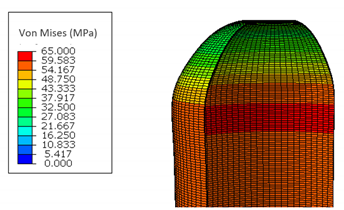 | 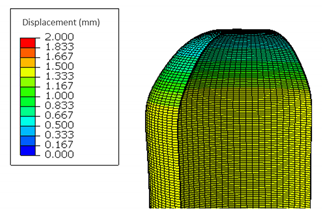 |
| [±70]6s | 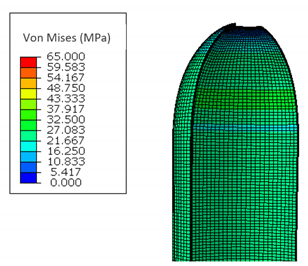 |  |
© 2020 by the authors. Licensee MDPI, Basel, Switzerland. This article is an open access article distributed under the terms and conditions of the Creative Commons Attribution (CC BY) license (http://creativecommons.org/licenses/by/4.0/).
Share and Cite
Reynaldo, A.; Pramono, H.S.; Santosa, S.P.; Aziz, M. Finite Element Analysis of Liquefied Ammonia Tank for Mobility Vehicles Employing Polymers and Composites. Energies 2020, 13, 5312. https://doi.org/10.3390/en13205312
Reynaldo A, Pramono HS, Santosa SP, Aziz M. Finite Element Analysis of Liquefied Ammonia Tank for Mobility Vehicles Employing Polymers and Composites. Energies. 2020; 13(20):5312. https://doi.org/10.3390/en13205312
Chicago/Turabian StyleReynaldo, Alvin, Hari Sidik Pramono, Sigit Puji Santosa, and Muhammad Aziz. 2020. "Finite Element Analysis of Liquefied Ammonia Tank for Mobility Vehicles Employing Polymers and Composites" Energies 13, no. 20: 5312. https://doi.org/10.3390/en13205312
APA StyleReynaldo, A., Pramono, H. S., Santosa, S. P., & Aziz, M. (2020). Finite Element Analysis of Liquefied Ammonia Tank for Mobility Vehicles Employing Polymers and Composites. Energies, 13(20), 5312. https://doi.org/10.3390/en13205312






